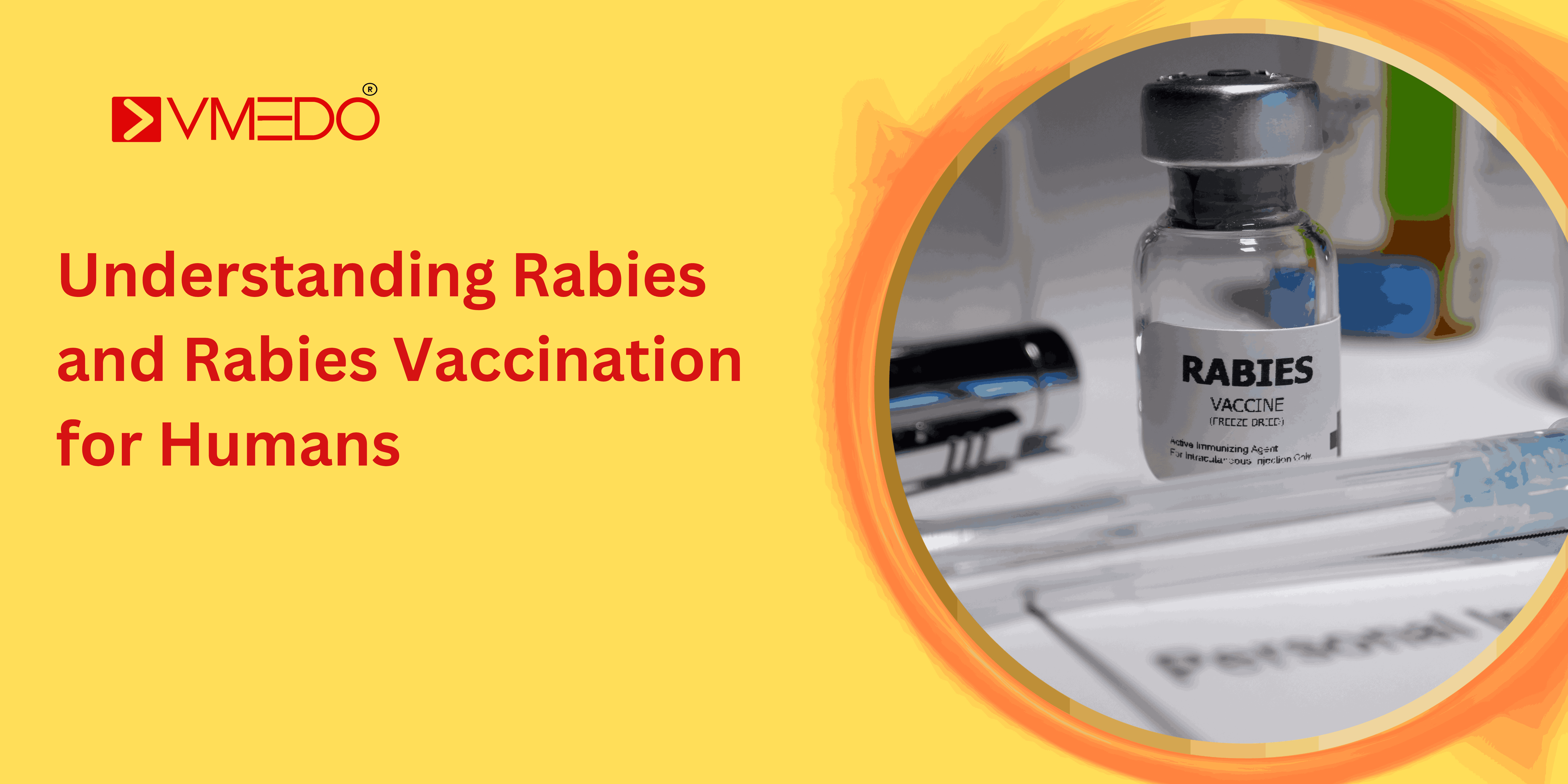Rabies is a viral disease that affects the central nervous system (brain and spinal cord) of mammals, including humans. It is caused by the rabies virus, which is typically transmitted through the bite of an infected animal. Rabies is a zoonotic disease, meaning it can be transmitted from animals to humans.
Once the rabies virus enters the body, it travels along nerve fibers to the brain, where it causes inflammation and damage. If left untreated, rabies is almost always fatal, with death usually occurring within days to weeks after the onset of symptoms.
Early symptoms of rabies in humans may include fever, headache, weakness, and discomfort at the site of the bite. As the disease progresses, symptoms such as anxiety, confusion, hallucinations, paralysis, and hydrophobia (fear of water) may develop.
Rabies is primarily transmitted through the saliva of infected animals, typically through bites. However, it can also be transmitted through scratches, abrasions, or mucous membranes coming into contact with infected saliva.
Prevention of rabies is crucial and is primarily achieved through vaccination. Vaccinating pets, such as dogs and cats, helps prevent the spread of rabies to humans. In the event of potential rabies exposure, immediate medical treatment, including post-exposure prophylaxis (PEP) with rabies vaccine and rabies immunoglobulin, is essential to prevent the onset of symptoms and ensure a favorable outcome.
Overall, rabies is a serious and potentially deadly disease that requires prompt medical attention and preventive measures to protect both humans and animals from infection.
Symptoms of rabies
Rabies is a viral disease that affects the central nervous system and is typically transmitted through the bite or scratch of an infected animal. The symptoms of rabies can vary depending on the stage of the infection. Here are the symptoms typically associated with rabies:
Prodromal Stage (Early Symptoms):
The prodromal stage usually lasts for 2 to 10 days after exposure to the rabies virus. Symptoms during this stage may include:
- Fever
- Headache
- Malaise (general feeling of discomfort or illness)
- Fatigue
- Pain, itching, or tingling at the site of the bite or scratch
Acute Neurologic Phase (Furious Rabies):
After the prodromal stage, rabies progresses to the acute neurologic phase, which is characterized by severe symptoms. This phase typically lasts for 2 to 7 days and may include:
- Agitation
- Confusion
- Hallucinations
- Hydrophobia (fear of water)
- Aerophobia (fear of drafts of air or of fresh air)
- Hypersalivation (excessive salivation)
- Difficulty swallowing
- Seizures
- Paralysis
Paralytic Stage (Dumb Rabies):
In some cases, rabies may progress to the paralytic stage, also known as “dumb rabies.” Symptoms during this stage may include:
- Weakness or paralysis, usually starting in the extremities and spreading inward
- Difficulty speaking or swallowing
- Loss of muscle function
- Respiratory failure
- Coma
Prevention/ Treatment for rabies
Prevention and treatment for rabies are essential to protect against this deadly viral disease. Here are key measures for prevention and treatment:
- Vaccination:
- The most effective way to prevent rabies is through vaccination. Pre-exposure vaccination is recommended for individuals at high risk of exposure to the rabies virus, such as veterinarians, animal handlers, travelers to rabies-endemic areas, and laboratory workers.
- Avoidance of Animals:
- Avoid contact with wild animals, especially bats, raccoons, skunks, and foxes, which are common carriers of the rabies virus. Do not approach or handle unfamiliar animals, and teach children to stay away from stray animals.
- Pet Vaccination:
- Ensure that pets, including dogs, cats, and ferrets, are vaccinated against rabies according to local laws and veterinary recommendations. Keeping pets up to date on rabies vaccination helps prevent transmission of the virus to humans.
- Animal Control Measures:
- Support animal control efforts to reduce the population of stray and potentially rabid animals in communities. Report any stray or aggressive animals to local authorities for appropriate action.
- Proper Wound Care:
- If bitten or scratched by an animal, promptly clean the wound with soap and water for at least 15 minutes and seek medical attention immediately. Proper wound care reduces the risk of rabies transmission.
Treatment:
- Post-Exposure Prophylaxis (PEP):
- If bitten or scratched by a potentially rabid animal, immediate medical attention is necessary to receive post-exposure prophylaxis (PEP). PEP involves a series of rabies vaccine injections administered as soon as possible after exposure, along with rabies immunoglobulin for severe exposures.
- Vaccine Administration:
- Rabies vaccines are typically administered in a series of doses over several weeks. The exact number of doses and schedule may vary depending on factors such as the individual’s age, health status, and the severity of exposure.
- Monitoring and Follow-Up:
- Individuals receiving PEP should be closely monitored for any signs of rabies infection during and after the vaccination series. Any adverse reactions or unusual symptoms should be reported to healthcare providers promptly.
- Supportive Care:
- In cases where rabies infection is suspected or confirmed, supportive care may be provided to manage symptoms and complications. However, once clinical symptoms of rabies appear, the disease is almost always fatal.
Rabies vaccination
The rabies vaccine plays a crucial role in preventing rabies by stimulating the immune system to produce antibodies against the rabies virus. Here’s how the rabies vaccine works to prevent rabies:
- Immune Response Activation:
- When a person receives the rabies vaccine, either through pre-exposure prophylaxis (PreP) or post-exposure prophylaxis (PEP), the vaccine contains viral antigens derived from inactivated rabies virus particles. These antigens are recognized by the immune system as foreign invaders.
- Antibody Production:
- In response to the presence of rabies antigens, the immune system mounts an immune response by producing specific antibodies against the rabies virus. These antibodies are designed to neutralize and eliminate the virus if encountered in the future.
- Memory Cells Formation:
- Along with antibody production, the immune system also generates memory cells, including memory B cells and memory T cells. These memory cells “remember” the rabies virus antigens and remain in the body to provide long-term immunity.
- Protection Against Rabies Virus:
- After receiving the rabies vaccine, the body develops immunity to the rabies virus. If an individual is subsequently exposed to the rabies virus, either through a bite or scratch from an infected animal or another route of exposure, the immune system quickly recognizes the virus and mounts a rapid response.
- Prevention of Rabies Infection:
- The presence of pre-formed antibodies and memory cells allows the immune system to neutralize and eliminate the rabies virus before it can establish an infection in the body. This prevents the onset of rabies disease and protects the individual from developing rabies symptoms.
- Effective Protection:
- Rabies vaccination is highly effective in preventing rabies when administered promptly and according to recommended schedules. Pre-exposure vaccination establishes immunity before potential exposure occurs, while post-exposure vaccination protects against exposure to the rabies virus.
History and Types of Rabies Vaccination
Rabies vaccination has a long history of development and has played a crucial role in preventing the spread of this deadly viral disease. Here’s an overview of rabies vaccination, including its history and types:
History of Rabies Vaccination:
- Early History:
- The concept of vaccination against rabies dates back to the late 19th century when Louis Pasteur, a French microbiologist, developed the first rabies vaccine. Pasteur’s groundbreaking work in 1885 involved the development of a vaccine using attenuated (weakened) rabies virus, which he successfully tested on animals and humans.
- Pasteur’s Vaccine:
- Pasteur’s rabies vaccine, known as the “Pasteur vaccine” or “rabies vaccine,” revolutionized the prevention of rabies worldwide. The vaccine’s efficacy in preventing rabies infection was demonstrated through extensive clinical trials and became the standard approach for rabies vaccination.
- Advancements in Vaccine Technology:
- Over the years, advancements in vaccine technology have led to the development of various rabies vaccines, including improved formulations, production methods, and delivery systems. These advancements have enhanced the safety, efficacy, and accessibility of rabies vaccination worldwide.
Types of Rabies Vaccination:
- Pre-Exposure Prophylaxis (PreP): Pre-exposure prophylaxis (PreP) involves administering the rabies vaccine to individuals at high risk of exposure to the rabies virus, such as veterinarians, animal handlers, travelers to rabies-endemic areas, and laboratory workers. PreP helps establish immunity against rabies before potential exposure occurs, providing protection in case of subsequent exposure.
- Post-Exposure Prophylaxis (PEP): Post-exposure prophylaxis (PEP) is administered to individuals who have been bitten, scratched, or otherwise exposed to the rabies virus. PEP involves a series of rabies vaccine injections, typically administered along with rabies immunoglobulin (RIG) for severe exposures. Prompt initiation of PEP is crucial to prevent the onset of rabies symptoms.
- Inactivated Rabies Vaccines: Inactivated rabies vaccines, also known as killed rabies vaccines, contain inactivated rabies virus particles that stimulate the immune system to produce antibodies against rabies. These vaccines are safe and effective for both pre-exposure and post-exposure vaccination and are commonly used in rabies control programs worldwide.
- Modified Live Vaccines: Modified live rabies vaccines contain weakened rabies virus strains that induce a protective immune response without causing disease. These vaccines are primarily used in veterinary medicine for pre-exposure vaccination of animals, such as domestic dogs and wildlife, to prevent the spread of rabies in animal populations.
- Adjuvanted Vaccines: Adjuvanted rabies vaccines contain additional substances called adjuvants, which enhance the immune response to the vaccine antigens. Adjuvanted vaccines are designed to provide longer-lasting immunity and may be used in certain populations, such as immunocompromised individuals or those at high risk of rabies exposure.
Rabies vaccination schedule
The rabies vaccine schedule for humans typically consists of a series of vaccine doses administered over several weeks, depending on the individual’s vaccination status and risk of exposure to the rabies virus. Here’s an overview of the rabies vaccine schedule for humans:
Pre-Exposure Prophylaxis (PreP):
- Primary Vaccination Series:
- For individuals at high risk of exposure to the rabies virus, such as veterinarians, animal handlers, travelers to rabies-endemic areas, and laboratory workers, pre-exposure prophylaxis (PreP) is recommended. The primary vaccination series usually consists of three doses of rabies vaccine administered intramuscularly on days 0, 7, and either day 21 or day 28.
- Booster Doses:
- After completing the primary vaccination series, booster doses of rabies vaccine may be recommended for continued protection against rabies. Booster doses are typically administered every 1 to 3 years, depending on the individual’s risk of exposure and antibody titers.
Post-Exposure Prophylaxis (PEP):
- Initiation of PEP:
- Post-exposure prophylaxis (PEP) is initiated after potential exposure to the rabies virus, such as a bite or scratch from a potentially rabid animal. PEP involves a series of rabies vaccine doses along with rabies immunoglobulin (RIG) for severe exposures.
- Vaccine Administration:
- The rabies vaccine is administered intramuscularly in the deltoid muscle or anterolateral thigh, depending on the age and weight of the individual. The PEP vaccination schedule typically consists of four or five doses of rabies vaccine administered on days 0, 3, 7, 14, and 28, following the WHO-recommended Essen or Zagreb regimen.
- Rabies Immunoglobulin (RIG):
- In addition to rabies vaccine doses, rabies immunoglobulin (RIG) may be administered to individuals with severe exposures to the rabies virus, such as deep or multiple wounds, particularly if the individual has not been previously vaccinated against rabies. RIG is administered once at the beginning of PEP, with the remaining vaccine doses.
- Completion of PEP:
- Completing the full course of PEP is essential for ensuring protection against rabies. Individuals should receive all vaccine doses according to the recommended schedule, even if they have previously received rabies vaccination.
Rabies vaccination side effects
Rabies vaccination is generally safe and well-tolerated, but like any vaccine, it can cause side effects in some individuals. Most side effects of the rabies vaccine are mild and temporary, resolving on their own without serious complications. However, in rare cases, more severe reactions may occur. Here are some common side effects of rabies vaccination:
- Pain, Redness, and Swelling at the Injection Site:
- Mild pain, redness, and swelling at the injection site are common side effects of the rabies vaccine. These symptoms typically resolve within a few days.
- Fever:
- Some individuals may experience low-grade fever after receiving the rabies vaccine. Fever is usually mild and short-lived.
- Headache:
- Headache is a common side effect reported by some individuals after rabies vaccination. It is usually mild and transient.
- Fatigue:
- Fatigue or tiredness may occur in some individuals following rabies vaccination. This side effect typically resolves on its own without intervention.
- Muscle or Joint Pain:
- Some individuals may experience muscle or joint pain after receiving the rabies vaccine. This symptom is usually mild and temporary.
- Nausea or Vomiting:
- Nausea or vomiting may occur in rare cases after rabies vaccination. These gastrointestinal symptoms are usually mild and resolve without specific treatment.
- Allergic Reactions:
- Severe allergic reactions to the rabies vaccine, such as anaphylaxis, are rare but possible. Symptoms of an allergic reaction may include hives, difficulty breathing, swelling of the face or throat, and rapid heartbeat. Immediate medical attention is required if an allergic reaction occurs.
- Neurological Reactions:
- Rarely, neurological reactions such as Guillain-Barre syndrome (GBS) or acute disseminated encephalomyelitis (ADEM) may occur following rabies vaccination. These reactions are extremely rare but require prompt medical evaluation if suspected.
How to get rabies vaccination
- Primary Care Physician or Family Doctor:
Your primary care physician or family doctor can assess your risk of rabies exposure and administer the rabies vaccine if PreP is recommended.
- Public Health Departments:
Public health departments may provide rabies vaccination services, particularly for individuals at high risk of exposure to the rabies virus, such as animal control workers, wildlife rehabilitators, and laboratory personnel.
- Govt/ Private Hospitals
Hospital emergency departments are equipped to handle medical emergencies, including rabies exposure incidents. They can provide evaluation, treatment, and administration of rabies vaccination for individuals requiring PEP.
- Veterinary Clinics:
Veterinary clinics may offer rabies vaccination for individuals at risk of animal exposure, such as veterinarians, animal shelter workers, and pet owners.
- Occupational Health Clinics:
Occupational health clinics may provide rabies vaccination for workers in occupations with potential exposure to the rabies virus, such as animal handlers, wildlife biologists, and laboratory technicians.
- Community Health Centers:
Community health centers may offer rabies vaccination services as part of their preventive health programs for community members at risk of rabies exposure.
New-age home healthcare agencies who are offering vaccinations at home may also offer rabies vaccination at home for individuals requiring PEP



